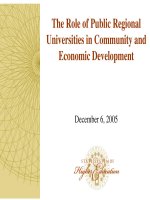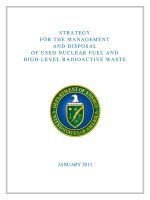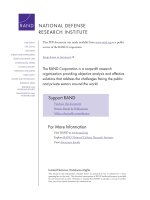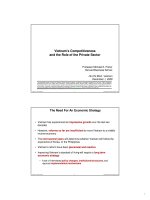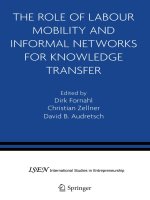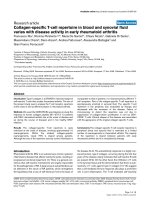The role of information asymmetry and the level of market trading activity in shaping the time to maturity pattern of futures return volatility
Bạn đang xem bản rút gọn của tài liệu. Xem và tải ngay bản đầy đủ của tài liệu tại đây (258.42 KB, 10 trang )
The Role of Information Asymmetry and the Level of Market
Trading Activity in Shaping the Time-to-Maturity Pattern of
Futures Return Volatility
by
Phan Hoang Long
Dissertation submitted for the degree of Doctor of Philosophy (PhD), School of
Accounting and Finance, Business School, The University of Adelaide.
January 2018
TABLE OF CONTENTS
TABLE OF CONTENTS ............................................................................................ i
LIST OF TABLES .................................................................................................... iii
LIST OF FIGURES .................................................................................................. vi
SYNOPSIS................................................................................................................ vii
DECLARATION .................................................................................................... viii
ACKNOWLEDGEMENTS ...................................................................................... ix
1.
INTRODUCTION ............................................................................................... 1
2.
THE IMPACT OF INFORMATION ASYMMETRY ON THE VOLATILITY
PATTERN ................................................................................................................ 13
2.1. Introduction ............................................................................................... 14
2.2. Related literature ........................................................................................ 19
2.3. Data and methods ..................................................................................... 244
2.4. Empirical results ...................................................................................... 322
2.4.1. The time-to-maturity pattern of information asymmetry ............................ 322
2.4.2. The impact of information asymmetry on futures return volatility ............. 377
2.4.3. The speculative effect and the price elasticity effect .................................... 40
2.5. An illustrative model of return volatility when uninformed liquidity hedgers
are unaware of their informational disadvantage....................................... 455
2.6. Robustness tests ....................................................................................... 499
2.7. Conclusion ............................................................................................... 633
i
3.
THE LEVEL OF FUTURES MARKET ACTIVITY AND THE SENSITIVITY
PATTERN .............................................................................................................. 644
3.1. Introduction ............................................................................................. 655
3.2. Data and method ........................................................................................ 70
3.3. Empirical results ...................................................................................... 744
3.3.1. The time-to-maturity pattern of trading volume and open interest .............. 744
3.3.2. The sensitivity pattern............................................................................... 777
3.3.3. Peak-to-maturity ....................................................................................... 833
3.3.4. The tilt of the sensitivity pattern and its impact on the linear test for the volatility
pattern ...................................................................................................... 866
3.3.5. Practical implications ................................................................................ 899
3.4. Conclusion ............................................................................................... 933
4.
CONTRIBUTIONS,
LIMITATIONS
AND
POTENTIAL
FUTURE
RESEARCH .......................................................................................................... 944
4.1. Contributions and practical implications ................................................... 955
4.2. Limitations and potential future research .................................................. 988
5.
CONCLUSION ............................................................................................... 100
APPENDIX ...........................................................................................................1033
REFERENCES .....................................................................................................1133
ii
LIST OF TABLES
Table 2.1:
Descriptive statistics............ ................................................................ 28
Table 2.2:
Univariate tests of the relationship between information asymmetry and
time-to-maturity .................................................................................. 33
Table 2.3:
Testing the time-to-maturity pattern of information asymmetry without
controlling for seasonality and liquidity. .............................................. 35
Table 2.4:
Testing the time-to-maturity pattern of information asymmetry with
controlling for seasonality and liquidity. .............................................. 36
Table 2.5:
Testing the impact of information asymmetry and time-to-maturity on
return volatility................................................................................... 38
Table 2.6:
The speculative effect and the price elasticity effect ............................ 41
Table 2.7:
Testing the mediating role of information asymmetry on the return
volatility –
time-to-maturity
relationship
when
controlling
for
autocorrelation in return volatility ...................................................... 50
Table 2.8:
Testing the mediating role of information asymmetry on the return
volatility – time-to-maturity relationship using Huang and Stoll’s (1997)
adverse selection component of the bid-ask spread .............................. 54
Table 2.9:
Testing the mediating role of information asymmetry on the return
volatility – time-to-maturity relationship using the Madhavan, Richardson
and Rooman’s (1997) information asymmetry component measured as
percentage of the bid-ask spread .......................................................... 56
iii
Table 2.10:
Testing the mediating role of information asymmetry on the return
volatility – time-to-maturity relationship during the 2007-2009 crisis
period .................................................................................................. 59
Table 2.11:
Testing the mediating role of information asymmetry on the return
volatility – time-to-maturity relationship after the 2007-2009 crisis period
............................................................................................................ 61
Table 3.1:
Summary statistics .............................................................................. 72
Table 3.2:
Testing the time-to-maturity pattern of trading volume and open
interest ................................................................................................ 75
Table 3.3:
Univariate test for the change in SENSITIVITY over the futures contract
life ...................................................................................................... 78
Table 3.4:
Testing the sensitivity pattern .............................................................. 80
Table 3.5:
Testing the sensitivity pattern using only news headlines containing the
name of the commodity ....................................................................... 82
Table 3.6:
Analysing the shape of the time-to-maturity pattern of trading volume,
open interest and SENSITIVITY. ........................................................ 84
Table 3.7:
Testing the linear volatility pattern ...................................................... 88
Table 3.8:
Comparing the volatility of the closest-to-peak and the closest-to-maturity
futures price series............................................................................... 92
Appendix Table 1: Specifications of commodity futures contracts.......................... 104
Appendix Table 2: Historical maintenance margin during the period 2003-2016 .... 105
iv
Appendix Table 3: Testing
the
sensitivity
pattern
using
ten-minute
realized
volatility................................................................................... 111
Appendix Table 4: Testing the sensitivity pattern using the natural logarithm of the
number of days to maturity as time-to-maturity ........................ 112
v
LIST OF FIGURES
Figure 1.1:
Hong’s proposal of the time-to-maturity pattern of information
asymmetry, the speculative effect (Samuelson effect), the price elasticity
effect, and the overall effect .................................................................. 5
Figure 1.2:
Average trading volume and open interest over the contract life for
September wheat futures contracts traded during the period 20032016 ..........................................................................................................7
Figure 2.1:
The mediation framework to separate the speculative effect and the price
elasticity effect .................................................................................... 30
Figure 2.2:
The impact of the speculative effect on the time-to-maturity pattern of
return volatility................................................................................... 43
Figure 3.1:
The sensitivity pattern ......................................................................... 81
vi
SYNOPSIS
I consider two explanations for the mixed empirical results on the Samuelson effect,
which postulates that futures return volatility increases closer to maturity when the
futures price becomes more sensitive to information flows. First, I empirically investigate
Hong’s (2000) theoretical suggestion that information asymmetry has an impact on the
time-to-maturity pattern of commodity futures return volatility (the “volatility pattern”)
by testing the relationships information asymmetry has with the time-to-maturity and
return volatility of commodity futures. I find that information asymmetry rises as
commodity futures near maturity and that this increases return volatility. Thus, this
“speculative effect” amplifies return volatility and can potentially be a more significant
driver of the volatility pattern than Samuelson’s (1965) price elasticity effect.
Second, I directly examine the time-to-maturity pattern of the sensitivity of futures return
volatility to information flows (the “sensitivity pattern”) and find that it has an inverted
U-shape. I point out that the results for tests of a linear volatility pattern are more
significant when the inverted U-shape of the sensitivity pattern tilts more towards
maturity. As an example of the practical implication of my findings, I show that a futures
price series constructed based on contracts that are closest to the peak of the sensitivity
pattern captures higher volatility (9.98% in-sample and 2.63% out-of-sample) than the
often used closest-to-maturity series.
vii
DECLARATION
I certify that this work contains no material which has been accepted for the award of
any other degree or diploma in my name, in any university or other tertiary institution
and, to the best of my knowledge and belief, contains no material previously published
or written by another person, except where due reference has been made in the text.
I give consent to this copy of my thesis, when deposited in the University Library, being
made available for loan and photocopying, subject to the provisions of the Copyright Act
1968.
I also give permission for the digital version of my thesis to be made available on the
web, via the University’s digital research repository, the Library Search and also through
web search engines, unless permission has been granted by the University to restrict
access for a period of time.
………………
……
…………
……
…………………………..
Phan Hoang Long
viii
ACKNOWLEDGEMENTS
I am extremely grateful to my principle supervisor, Professor Ralf Zurbrügg, for his
invaluable help and supervision. He has been very patient and guided me through every
step through my PhD program. The knowledge and skills I learnt from him are
invaluable. Without him, this thesis would not have been possible. I want to extend my
sincere gratitude to my external supervisor, Professor Paul Brockman, for his invaluable
expertise and instruction. I sincerely thank Yessy Peranginangin, my co-supervisor, for
his constant help and encouragement. I am grateful to Jeffrey Chia-Feng Yu for teaching
me Finance Theory and helping me develop the theoretical model in this thesis. My
special thanks to Associate Professor Dirk Boehe who has helped me to broaden my
knowledge in international business. I also wish to thank George Mihaylov for
proofreading this thesis.
I also owe a debt of gratitude to Professor Richard Russell and Ms Sandy McConachy
for introducing me to the University of Adelaide and helping me apply for the Beacon of
Light Scholarship. I wish to extend my gratitude to all the staff at the Adelaide Business
School for their help and support, especially Chee, Gary, and Phương. I thank my fellow
PhD friends, particularly Long, Sylvia, Emon, Sasha, Sherley, Jin, Thanh, Dưỡng, Dung
and My, for their kindness.
Last but not the least, I would like to thank my family for their understanding and
enormous support. Without them, I would not have been able to complete this thesis.
ix

